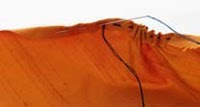Below, we'd like to share some handy fabric-selecting tips with you from two of doll expert Joan Hinds' popular books, All Dolled Up and Doll Fashion Studio:
 |
| Flowered Party Dress |
 |
| Embroidered Jeans |
Knits - Knits are good to use for making doll T-shirts. Many people may hesitate to sew with knits, but they're not difficult to work within the T-shirts since the smaller pieces tend not to stretch as much as larger ones. Sewing with knits only requires a few minor changes:
• Make sure your sewing machine needle is appropriate for knits.
• The seams in the knit garments are quite short, which helps eliminate stretching. Use a straight or zigzag stitch if using your sewing machine, or stitch the seams with a serger.
• You may want to try a double needle for hems on shirts and leggings.
 |
| Fleece Vest |
 |
| Classic Nightgown |
 |
| Rainy Day Fashion Raincoat |
• Only put pins inside the seam allowance when cutting and sewing your fabric. Pins will leave a permanent mark on the fabric. Try using double-sided or cellophane tape to hold the fabrics together when cutting and sewing.
• Do not press the fabric from the right side because the coating on the fabric will melt. Press only if needed on the wrong side or on the lining side.
• Use a sharp needle, size 12, with a 1/8-inch stitch length. If needed, try a Teflon-coated presser foot when topstitching to keep the foot from sticking.
Scale - Larger-scale prints can look great in doll clothing if they match a girl's outfit. Sometimes, prints have companion fabrics with both large- and small-scale motifs. If you're making matching outfits for a girl and doll, use the larger pattern for girls and the smaller one for dolls.
Weight - The weight of the fabric will have a bearing on some of the techniques used. For example, some garments in All Dolled Up have a ruffle that is made by doubling the width of the fabric. It is folded in half with wrong sides together and stitched to the garment. The need for a hem is eliminated, and the ruffle has more body. If you're using a cotton fabric for a doll garment, a double fabric ruffle will be appropriate. If you're using a heavier flannel, the doll ruffles consist of only a single layer of fabric. You may need to adjust the pattern depending on your fabric choice.
 |
| Sewing Secrets for Doll Clothing |
Sew On, Sew Well, Sew Beautiful,
Cyndi and Amelia













































